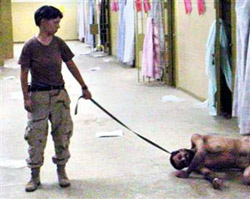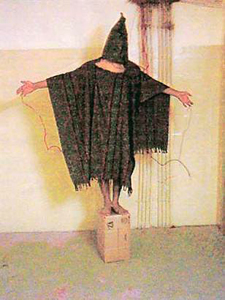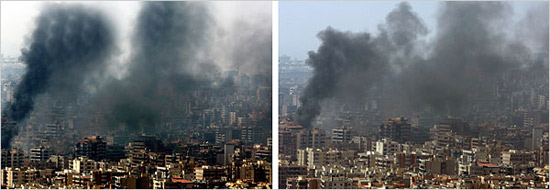“China Power of Photography, 2006” by Vicki Goldberg |
part 1 | part 2 | part 3 | part 4
Digitization has convinced everyone that photographs lie, but there are classes of photos that everyone still believes. When a photograph proves that a horse won by a nose, we believe it and give that horse a prize. When an X-ray shows a tumor in the brain, we believe it too, and an operation follows.
And there are classes of photographs that gain power partly by being so plentiful, so that individual pictures may seldom make much difference but the sheer weight of large numbers sending the same message over and over exerts a heavy influence. I think primarily of advertising photography, including television commercials, billboards, pop-up ads on the net. In America, at least, and presumably in capitalist countries generally, advertisements set many cultural scenarios: what’s cool, what’s sexy, what’s healthy, what’s good looking, masculine or feminine, what’s prestigious.
More meaningfully still, they do exactly what they are meant to do: they create an atmosphere of desire and a strong urge to consume. Advertising is necessary in economies where production outstrips necessity; people must be encouraged to buy things they do not absolutely need. The photographs feature beautiful people in beautiful homes leading beautiful lives. Ordinary items are turned into compelling, even fetishistic objects by the power of the camera. Even though we know that ads lie and exaggerate, their constant repetition stirs up vague discontents, envy, and hopes, and whatever they advertise the real message is the same: BUY IT -- so these photographs are vital to the manufacture of one major product of the late twentieth and early twenty-first century: consumerism.
Another class of photographs that wields a strong influence as a class rather than as single images is the class of astronomical photographs. These have been thrilling since the first pictures of the moon were taken in the nineteenth century, but the Hubble telescope, Chandra, the X-ray telescope, radio telescopes and the power of digital imagery sent across millions of miles of space have for some time been changing our view of the universe.
Earth was already relegated to a minor position in the cosmos by the Apollo 8 photographs, but now we have a true window into the solar system and so far beyond that we have come surprisingly close to the beginning of it all.
NASA: DETAIL OF ORION CONSTELLATION
That has created religious controversies, philosophical inquiries and spiritual yearnings that I think must have amplified the mystique surrounding the turn of the millenium.
NASA: MARS
The world is breathless to know if there is the possibility that life existed on Mars or elsewhere, a riddle at the heart of humanity’s view of itself. When the first successful fly-by of Mars took place in 1965 and the first photographs of that planet came back, some wag said that one word would have been worth a thousand pictures.
Some individual pictures taken back on our planet still have the power to move minds and spur actions.
9/11: SEPTEMBER 11, 2001
The pictures of the destruction of the World Trade Center on September 11, 2001, stirred horror and sympathy across most of the world.
Very few images of the current war in Iraq will be remembered, no matter how wonderfully they were composed or how urgent the action they depicted, but some amateur pictures taken with cell phones surely will be. The Abu Ghraib photographs, made by soldiers who participated in the abuse, have been seen by millions upon millions and become instantly recognizable icons of the most unholy sort.
 |
"Man on Leash" © Lynndie England |
© Abu Ghraib |
GRAFFITO OF THE PRISONER AND STATUE OF LIBERTY, IRAQ |
Their effect hinges on two elements: the content of the pictures, and digitization. The content has entirely discredited the moral stance of the United States, bred hatred for it in millions of hearts and served as the excuse for if not the cause of any number of attacks on Americans in Iraq. But the power of these photographs to influence many minds stems from digitization. Digitization of cameras, mass ownership of such cameras, including cell phone cameras, wide ownership of scanners and access to the net have made it easy to put photographs of anything and everything onto the web, so that a culture has grown up that says that just about whatever you do is worth photographing and sharing with your friends or even with untold numbers of people you will never know.
Soldiers now can have tiny cameras and take pictures on the spot, pictures by amateurs with no training but with access to places that professional photojournalists do not have. These pictures can reach friends, families, or immense publics without ever being censored by the military or by editors, essentially a new phenomenon in the history of war photography. The secret of their power is in the distribution network. It is immense, uncontrolled, and largely uncontrollable.
This distribution network has spawned other changes in war photography. “Live” coverage of deadly scenes in “real time” is one, but I’m thinking particularly of the videos and stills or frame grabs of terrorist beheadings of kidnapped prisoners. These images have a dual purpose: to strike terror into the hearts of the kidnappers’ enemies, and to recruit combatants to the terrorist cause. They have been quite successful in both purposes. In the past, I believe that pictures of wartime brutality – pictures of World War II concentration camp victims, for instance, even Eddie Adams’s picture of General Loan executing a suspect -- have chiefly been used and been read as evidence that people who committed such atrocities are evil and are enemies. Yet here we have the paradox that photographs of brutality on our side, such as the Abu Ghraib pictures, make recruitment more difficult, while photographs of brutality on the other side have aided recruitment and are thought to have provoked additional beheadings by convincing some that Islam can become great again via terrorism.
 |
"Reuters" © Adnan Hajj |
The issue of manipulating digital photographs is also a major issue. This photograph of an explosion in Beirut during the war ini Lebanon last August was digitally doctored by the photographer to increase and darken the smoke, making the damage to the city look even worse than it was. The Los Angeles Times printed the photograph without realizing it had been manipulated. When that was pointed out, the paper fired the photographer. The care that news organizations take to assure the public that the photographs tell the truth is itself an acknowledgement that photographs, which were already powerful in the 19th century and exerted that power across the twentieth, continue to do so in the 21st century.
Vicki Goldberg©2006
vickigoldberg@gmail.com



